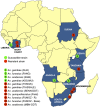Electrostatic coating enhances bioavailability of insecticides and breaks pyrethroid resistance in mosquitoes
- PMID: 26324912
- PMCID: PMC4593083
- DOI: 10.1073/pnas.1510801112
Electrostatic coating enhances bioavailability of insecticides and breaks pyrethroid resistance in mosquitoes
Abstract
Insecticide resistance poses a significant and increasing threat to the control of malaria and other mosquito-borne diseases. We present a novel method of insecticide application based on netting treated with an electrostatic coating that binds insecticidal particles through polarity. Electrostatic netting can hold small amounts of insecticides effectively and results in enhanced bioavailability upon contact by the insect. Six pyrethroid-resistant Anopheles mosquito strains from across Africa were exposed to similar concentrations of deltamethrin on electrostatic netting or a standard long-lasting deltamethrin-coated bednet (PermaNet 2.0). Standard WHO exposure bioassays showed that electrostatic netting induced significantly higher mortality rates than the PermaNet, thereby effectively breaking mosquito resistance. Electrostatic netting also induced high mortality in resistant mosquito strains when a 15-fold lower dose of deltamethrin was applied and when the exposure time was reduced to only 5 s. Because different types of particles adhere to electrostatic netting, it is also possible to apply nonpyrethroid insecticides. Three insecticide classes were effective against strains of Aedes and Culex mosquitoes, demonstrating that electrostatic netting can be used to deploy a wide range of active insecticides against all major groups of disease-transmitting mosquitoes. Promising applications include the use of electrostatic coating on walls or eave curtains and in trapping/contamination devices. We conclude that application of electrostatically adhered particles boosts the efficacy of WHO-recommended insecticides even against resistant mosquitoes. This innovative technique has potential to support the use of unconventional insecticide classes or combinations thereof, potentially offering a significant step forward in managing insecticide resistance in vector-control operations.
Keywords: electrostatic coating; insecticide; malaria; mosquito; resistance management.
Conflict of interest statement
Conflict of interest statement: R.A., J.S., R.A.S., A.J.O., B.G.J.K., and M.F. are remunerated by or receive compensation for services delivered to In2Care BV and hold shares in In2Care BV. In2Care BV has one or more patents or patent applications related to the subject of this paper.
Figures







Similar articles
-
Multi-country field trials comparing wash-resistance of PermaNet and conventional insecticide-treated nets against anopheline and culicine mosquitoes.Med Vet Entomol. 2005 Mar;19(1):72-83. doi: 10.1111/j.0269-283X.2005.00543.x. Med Vet Entomol. 2005. PMID: 15752180
-
Mosquitoes and bednets: testing the spatial positioning of insecticide on nets and the rationale behind combination insecticide treatments.Ann Trop Med Parasitol. 2008 Dec;102(8):717-27. doi: 10.1179/136485908X337553. Ann Trop Med Parasitol. 2008. PMID: 19000389
-
Efficacy of six neonicotinoid insecticides alone and in combination with deltamethrin and piperonyl butoxide against pyrethroid-resistant Aedes aegypti and Anopheles gambiae (Diptera: Culicidae).Pest Manag Sci. 2013 Aug;69(8):905-10. doi: 10.1002/ps.3446. Epub 2012 Dec 4. Pest Manag Sci. 2013. PMID: 23208775
-
Impact of environment on mosquito response to pyrethroid insecticides: facts, evidences and prospects.Insect Biochem Mol Biol. 2013 Apr;43(4):407-16. doi: 10.1016/j.ibmb.2012.10.006. Epub 2012 Oct 31. Insect Biochem Mol Biol. 2013. PMID: 23123179 Review.
-
Systematic review of indoor residual spray efficacy and effectiveness against Plasmodium falciparum in Africa.Nat Commun. 2018 Nov 26;9(1):4982. doi: 10.1038/s41467-018-07357-w. Nat Commun. 2018. PMID: 30478327 Free PMC article.
Cited by
-
Passive Outdoor Host Seeking Device (POHD): Designing and Evaluation against Outdoor Biting Malaria Vectors.ScientificWorldJournal. 2020 Jul 1;2020:4801068. doi: 10.1155/2020/4801068. eCollection 2020. ScientificWorldJournal. 2020. PMID: 32694955 Free PMC article.
-
Semifield Evaluation of Improved Passive Outdoor Host Seeking Device (POHD) for Outdoor Control of Anopheles arabiensis Mosquitoes.ScientificWorldJournal. 2020 May 26;2020:8938309. doi: 10.1155/2020/8938309. eCollection 2020. ScientificWorldJournal. 2020. PMID: 32547328 Free PMC article.
-
Shift in dominant genotypes of Japanese encephalitis virus and its impact on current vaccination strategies.Front Microbiol. 2023 Nov 17;14:1302101. doi: 10.3389/fmicb.2023.1302101. eCollection 2023. Front Microbiol. 2023. PMID: 38045034 Free PMC article. Review.
-
Visualization of house-entry behaviour of malaria mosquitoes.Malar J. 2016 Apr 25;15:233. doi: 10.1186/s12936-016-1293-7. Malar J. 2016. PMID: 27108961 Free PMC article.
-
Mosquitoes cloak their legs to resist insecticides.Proc Biol Sci. 2019 Jul 24;286(1907):20191091. doi: 10.1098/rspb.2019.1091. Epub 2019 Jul 17. Proc Biol Sci. 2019. PMID: 31311476 Free PMC article.
References
-
- Petersen LR, Hayes EB. West nile virus in the Americas. Med Clin North Am. 2008;92(6):1307–1322, ix. - PubMed
-
- WHO 2014 World Malaria Report 2014 (World Health Organization, Geneva) Available at www.who.int/malaria/publications/world_malaria_report_2014/en/. Accessed June 3, 2015.
-
- WHO 2012 Global Plan for Insecticide Resistance Management in Malaria Vectors (World Health Organization, Geneva) Available at www.who.int/malaria/publications/atoz/gpirm/en/. Accessed June 3, 2015.
Publication types
MeSH terms
Substances
LinkOut - more resources
Full Text Sources
Other Literature Sources
Medical
Molecular Biology Databases

